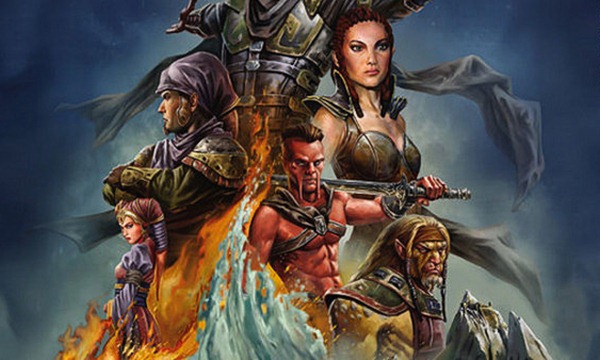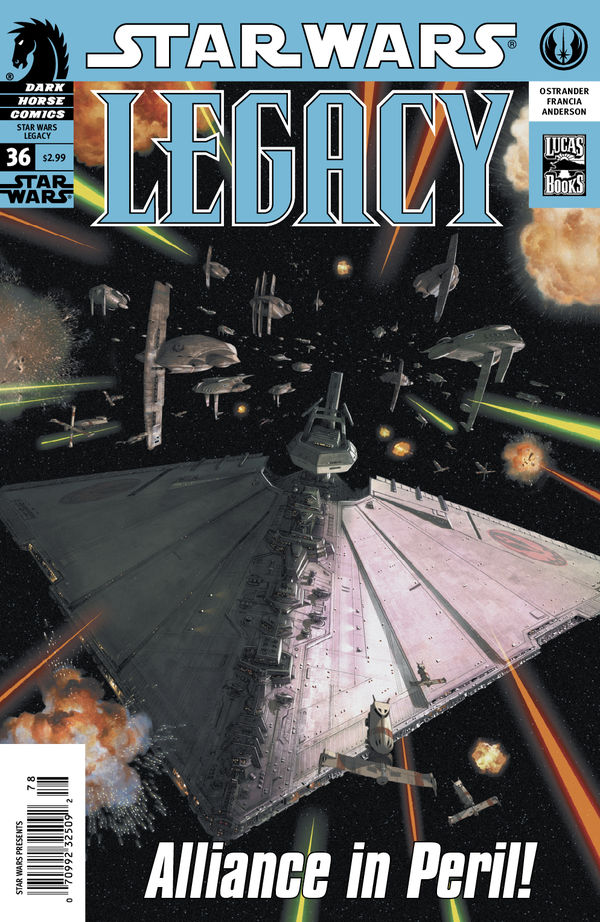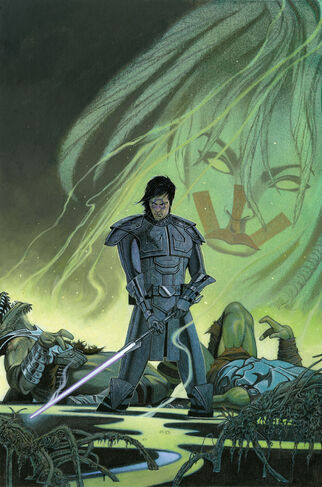
John Ostrander, alongside frequent collaborator Jan Duursema, has built up likely the most far-reaching Star Wars résumé ever—first with the prequel-era saga of Quinlan Vos, then far into the future with Luke Skywalker’s great (great?) grandson Cade in Legacy, and most recently going all the way back to the beginning in Dawn of the Jedi, which resumed this past month with the new miniseries Force War. If Star Wars history were a map, you could say that Ostrander/Duursema are the pins holding it up at the corners. John recently took the time to look back with us at Legacy‘s future, and forward at DotJ’s past.
Eleven-ThirtyEight: It’s been over seven years since Legacy first debuted in June 2007. You have been in the comic industry for decades and contributed to and/or created numerous titles. What are your thoughts on the impact Legacy had on the Expanded Universe and in your mind what is the legacy of this series?
John Ostrander: What is the legacy of Legacy? <g> To be honest – it beats me. Does it have one? It’s not something with which I concern myself very much. I do the work, I hope the stories entertain, and I let the legacy, if any, take care of itself.
ETE: One of the recurring themes in Legacy was trust. Cade trusting his destiny, the Moff Council’s erroneous trust in the Sith, Stazi’s lack of trust in Fel’s forces, and the galaxy in general’s lack of trust in the reformed Yuuzhan Vong are all examples of this. What was it about this theme of trust issues that compelled you to propel them to the forefront of Legacy?
JO: This may sound disingenuous, but Legacy grew its own themes. Certainly, we were using traditional SW themes like redemption, but Jan and I usually do what I call tale-weaving. We bring together this strand of story and that strand of story and a pattern starts to emerge, or more than one pattern. The concept of trust is like that. I am not sure that it was conscious on our part at the beginning but I can see how it picked itself up as we went.
ETE: It is often said that hindsight is 20/20. Looking back on the work you and Jan Duursema put into the Legacy series, are you satisfied with where it left off? Were there any parts that didn’t develop as you’d hoped, or big ideas that ended up discarded?
 JO: Both Jan and I had tons of story that we wanted to develop. The whole Battle of the Hidden Temple could have been an arc in and of itself, for example. I would have liked to develop the whole Hondo Carr/Mandalorian subplot. What we had was six issues with which to wind up the whole thing. I don’t think we did a bad job by any means and I’m glad we had the opportunity to wind up the series but, when you’re enjoying yourself, you always want more time, right?
JO: Both Jan and I had tons of story that we wanted to develop. The whole Battle of the Hidden Temple could have been an arc in and of itself, for example. I would have liked to develop the whole Hondo Carr/Mandalorian subplot. What we had was six issues with which to wind up the whole thing. I don’t think we did a bad job by any means and I’m glad we had the opportunity to wind up the series but, when you’re enjoying yourself, you always want more time, right?
ETE: A large reason for Legacy’s success and broad appeal was the various secondary storylines and characters that populated your universe. If you were given the chance to explore one of these, what would it be? And on a related note, have you been keeping up with Bechko and Hardman’s Legacy series?
JO: I do read the new Legacy series, just to see what’s going on. As for secondary characters, Stazi was always a favorite of mine as well as Nick’s. Probably my favorite from the secondary cast. As I said, I would have liked doing the whole Hondo Carr story. I can’t think of a single storyline and character I wouldn’t like to play with some more.
ETE: Moving on to Dawn of the Jedi: you’ve had the unique privilege of writing about not just the ancient Je’daii, but the prequel-era and far-future Jedi as well. Given how different the philosophies of the Je’daii are from the modern order(s), I wonder whether you see any of these groups as more empirically “correct” than the others. A Je’daii transplanted into Obi-Wan’s time would likely seem dangerously steeped in the dark side—would that be a mistaken impression? Or are there no right answers?
JO: Let’s just say I think there are reasons why they stopped being Je’daii and became Jedi. Yoda said that once you started down the path of the dark side, it would forever mark your destiny. I think Balance is a fine concept but I’m not sure if it’s workable. I think it’s absolutely correct that Obi-Wan would find a Je’daii too steeped in the dark side. Would he be right? After all, the Jedi Order also failed.
ETE: What’s always struck me about Ostrander/Duursema collaborations is the depth and clarity of your world-building. When approaching a totally new era like Legacy or Dawn of the Jedi, where do you start—with the characters, or the setting? How much of the Tython system, for example, sprang forth fully-formed, and how much arose out of specific stories you wanted to tell?
JO: We started out with what was already established or being established in the game. I call that “the given”. Then we started extrapolating from that – we knew how many planets were in the Tython system but none of them had names. We started, as I remember, setting the scene but the characters started assembling soon after and the setting was developed with the characters as we went. It’s never really one or the other, it’s and/both.
ETE: There’s another thing that’s always stood out to me about your work, but It’s hard for me to put into words. Compared to most comics writers nowadays, say JJM or Tom Taylor, your characters seem to speak with a certain…theatricality, I guess I would call it—most noticeably by frequently using each other’s full names. It’s interesting to me because while it meshes well with the melodramatic nature of the films, I think, it lends your stories a sort of veneer of formality that’s rarely the case in modern comics. I guess I’d just like to hear a bit about how you approach Star Wars dialogue, and whether the difference I’m describing is something you’re conscious of…or if it’s just me?
JO: Some of it is intentional. I want to keep with the style of the movies without, shall we say, the parts that hurt the ear. The use of the full names, especially among the Jedi, seems to be part of the way Jedi address other Jedi. With those characters, there is more of a formality. I think not so much with characters like Villie, for example. Stuff like that is looser and more colloquial. Just part of the texture we try to give to the stories.
ETE: Authors of both novels & comic books often say that writing a fleet battle is one of the more challenging aspects of the Expanded Universe. In the case of Legacy you wrote several massive & complicated battles, including the Battle of Ralltiir, the second battle of Dac, and the assault on Taivas. For starters, how do you craft a battle in your head and make it flow on paper? Secondly, how much direction do you give an artist like Jan Duursema or Omar Francia on what to visually depict in a battle scene?
JO: In general, I try not to give too much instruction to the artist, other than what should be there. I structure a fleet battle like I would any other fight scene – there are beats. Some battles seem complicated by the fact that there is more than one fight element at a time. Do a little bit with this character in this corner of the battle, and then switch to someone or something else, going on to a third, then maybe coming back to the first, resolving things at the right moment. Each panel has room for ONE primary action – any more and things get confusing fast. Set-up, delivery, consequence. The last thing you want is for the reader to get confused. If the action is not clear, the reader gets lost. Finally, it’s all about character and fight or action should reveal character. Fights or action sequences just for their own sake get boring pretty fast because they don’t really engage the reader. Explosions are cool but they should be in context of the story that you‘re trying to tell.
 ETE: Looking ahead to the upcoming arc Force War, it sounds like Xesh has been pretty firmly embraced by the Je’daii at this point. Per my earlier question about philosophy, this doesn’t seem like something the “modern” Jedi would be comfortable doing–good idea on their part, or bad idea? And if Xesh isn’t beyond redemption (or should I say balance?) does that bode well for Daegen Lok?
ETE: Looking ahead to the upcoming arc Force War, it sounds like Xesh has been pretty firmly embraced by the Je’daii at this point. Per my earlier question about philosophy, this doesn’t seem like something the “modern” Jedi would be comfortable doing–good idea on their part, or bad idea? And if Xesh isn’t beyond redemption (or should I say balance?) does that bode well for Daegen Lok?
JO: Uhhhhh. . .that’s all part of the story and figures into it so, for now, I’ll pass.
ETE: Lastly, I’d love to hear a little about your personal experience with Tim Lebbon’s Dawn of the Jedi novel Into the Void. Did the comic people first approach the novel people, or vice-versa? How much did you and Jan work with Lebbon behind the scenes, if at all? Any chance of Lanoree Brock popping up in Force War?
JO: Lucasfilm Licensing brought us in and so did Del Rey. We saw early versions of the plot and expressed our thoughts. Tim was working with what we had already written (even if it wasn’t yet published) but we were still developing the story and aspects of the characters and the settings as we went. I brought Lanoree and Hawk together in the short story I did for the book but we don’t plan to use her in the comic for the same reasons that we didn’t use the NJO era Jedi or their descendants in Legacy – we didn’t want to tie the novelists’ hands and we don’t want to do that with Tim in case he has another story to tell with her. We have plenty of story to tell without doing that.
Thanks to John for speaking with us! Issue #1 of Dawn of the Jedi: Force War is on the stands now, and #2 comes out this Wednesday.

One thought to “John Ostrander on Dawn of the Jedi, Legacy, and Character Versus Action”
Comments are closed.